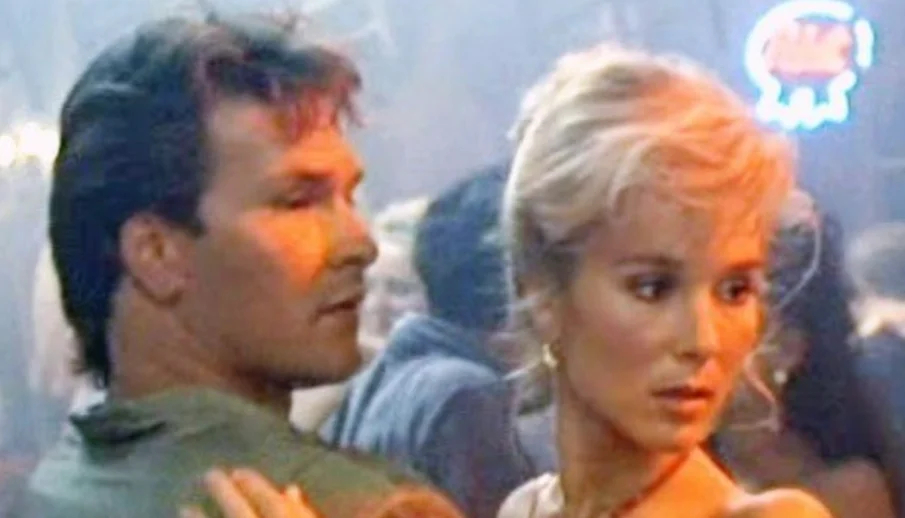
Cynthia Rhodes, known for her iconic roles in Staying Alive and Dirty Dancing, is a legendary figure in 1980s dance dramas. As she approaches her 68th birthday in November 2024, it’s worth reflecting on why this Hollywood triple threat chose to retire at the peak of her career.
Rhodes was born in Nashville, Tennessee, and began her career with a small part in the 1980 film Xanadu, which starred Olivia Newton-John and Gene Kelly. Her breakout came with her portrayal of Tina Tech in Flashdance, followed by a significant role in Staying Alive, where she played the love interest of John Travolta.
However, it was her unforgettable performance as Penny Johnson in Dirty Dancing that solidified her status in Hollywood. In this role, she captivated audiences with her Mambo dancing alongside Patrick Swayze, while also delivering poignant emotional scenes, including the character’s harrowing experience with an illegal abortion.

Rhodes described Penny as a complex character who had endured a tough life, yet retained a sense of sweetness. The film not only showcased her dancing skills but also tackled important social issues, positioning its leads, including Rhodes, for stardom.
Despite her success, Rhodes decided to step back from the industry, citing the physical demands of dance. “Dancing became really hard”, she said, expressing her desire for roles that didn’t involve strenuous movement. “I keep saying I’ll never dance again… my bones hurt, my back hurts all the time”, she explained.

In 1987, the same year Dirty Dancing premiered, Rhodes appeared in Richard Marx’s music video for “Don’t Mean Nothing”. She married Marx in 1989 and welcomed three children: Brandon in 1990, Lucas in 1992, and Jesse in 1994. Marx noted that Rhodes found more fulfillment in motherhood than in her previous career, which she left in 1990 partly due to the intense physical pain from dancing.
Rhodes, who started dancing at the age of three, emphasized her love for it but acknowledged the toll it took on her body. “If I never danced again, I wouldn’t regret it”, she said, highlighting her contentment in focusing on her family.
Her last film appearance was in 1991’s Curse of the Crystal Eye. After divorcing Marx in 2014, she stepped further into her role as a mother, watching her children pursue careers in the arts: Brandon as a music producer, Lucas as a singer and actor, and Jesse as a musician in a metal band. While fans miss seeing Cynthia Rhodes on screen, her decision to leave Hollywood resonates, underscoring the high demands of a career in dance and the joy she found in motherhood.
Kathy Bates: A Brave Warrior Fighting Against Cancer

Narratives of affluent Hollywood stars grappling with health issues serve as a reminder that they are akin to us. The Academy Award-winning actress Kathy Bates talked candidly about her fight with cancer and the difficulties she endured in silence during a recent interview on the Dr. Phil program. Even though she was well-known, Bates ended up portraying a brave heroine in a true story, overcoming cancer twice.

She said in 2012 that she had been cancer-free for nine years and had triumphantly battled ovarian cancer. But a few weeks ago, she received the heartbreaking news that she had breast cancer. She likened the moment she was given this devastating diagnosis as being in a room that was scarier than something from an American Horror Story.
In 2003, Bates had already gone through a trying time due to ovarian cancer. She kept her fight a secret while enduring grueling surgery and nine months of chemotherapy. She told just a select few people about it, including PEOPLE magazine, and stated, “It really took a lot out of me, but I didn’t want anyone to know.”
She overcame ovarian cancer and maintained her cancer-free status for many years because to her tenacity and fortitude. But when her doctor told her that the cancer had come back, this time in her breast, her fight was far from done. Bates wasn’t totally shocked by this setback, noting that breast cancer runs in her family.
Bates decided to have a double mastectomy in order to halt the spread of her breast cancer. She turned her tragedy into inspiration for other women rather than letting it break her soul. Bates kept her vibrant personality and sense of humor despite hardship. She cracked a joke, saying, “I miss ‘Harry’s Law’ more than my breasts,” and thanked her followers for their continuous support through her lowest points.
Bates no longer has cancer, but because her lymph nodes were removed, she now suffers from lymphedema. About 30% of breast cancer survivors have this illness, which makes daily living uncomfortable due to pain and edema. But Bates won’t allow it to define who she is. She candidly recounts her experience in an effort to inspire other women to make routine checkups a priority and to reassure them that they are not fighting this battle alone.
In addition, Bates has agreed to represent the Lymphatic Education & Research Network (LE&RN) by using her platform to advocate for people with lymphedema and to increase public awareness of the condition.
Bates has gained resilience and a sense of purpose over her experience. “I’m grateful that my difficulties have given me a sense of purpose,” she muses. It’s intriguing how events unfold in that manner.
The conversation with Kathy Bates illuminates the difficulties she overcame and offers hope to anyone who might be going through comparable struggles. Her experience serves as a reminder that, given enough willpower, empathy, and encouragement, we can turn our own hardships into assets.



Leave a Reply